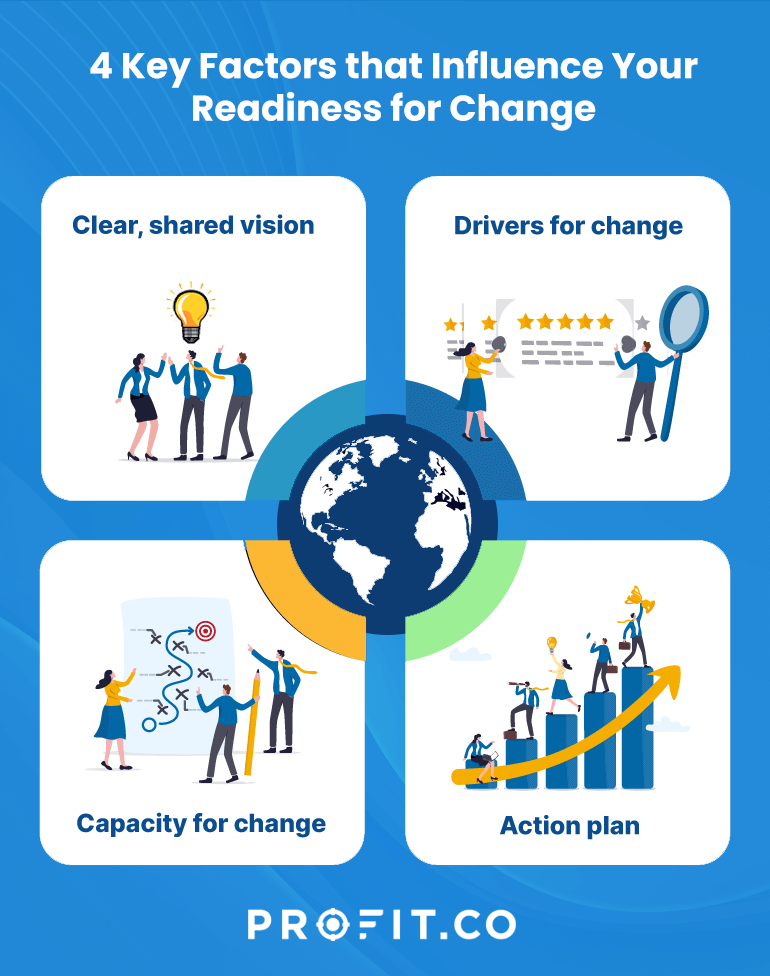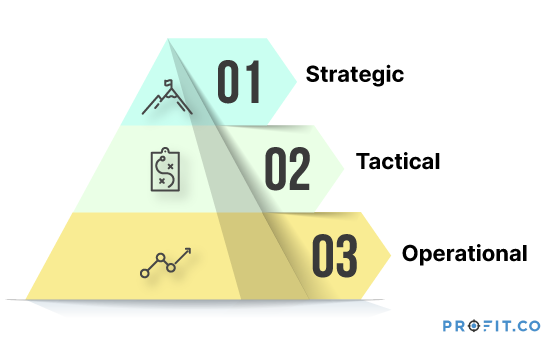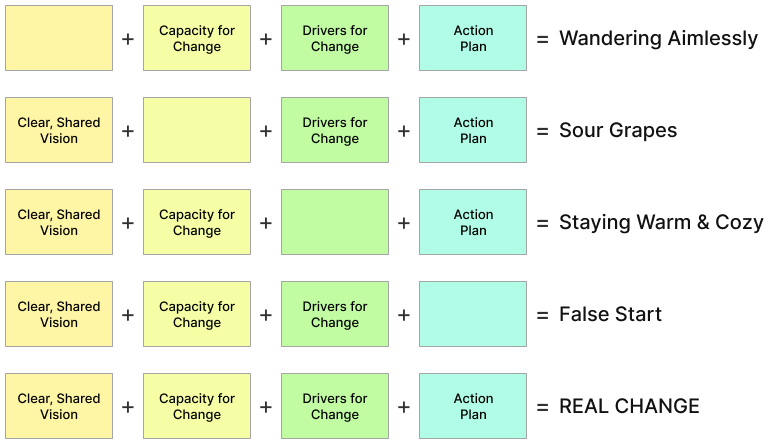There’s no question that organizational change happens every day, whether anticipated or unexpected. You learn new things from business activities, adjust your work culture to meet customer demands and overcome challenges to keep your company going. However, some changes need strategic planning and implementation.
So, how do you know that you are ready for a change?
Four Key Factors Influencing Your Readiness for a Change
When it comes to change management, it is a lot easier to understand if you are ready for change, before you embark on your journey. Can you change the status quo? Do you have a checklist that you can go through and identify particular items that can indicate that you’re ready for the change?
There are four key aspects that you should consider to assess if you are ready for a change:
- A clear and shared vision
- Capacity for change
- Drivers for change
- Actionable first steps
Let’s first look at each of these aspects and then see what happens when one is missing and the potential impact on your change management readiness.

A Clear and Shared Vision
The first aspect to consider is whether you have a clear and shared vision.
Change can only work if you align your values and vision across the organization. You typically have three layers of management – the strategic layer, typically the C-level of management, operating, and tactical layers.

If these layers lack aligned visions of where the business has to go, it will be challenging to take stock of your current position and determine the direction to take. You need a clear, shared, or aligned vision across the entire business. It is also critical that leaders throughout the organization become champions of this vision, setting expectations and encouraging others to embrace it. Leaders must ensure their teams have access to the resources they need to help them reach these goals.
Regular communication about progress toward reaching objectives can help keep everyone focused on achieving success. This could take many forms, such as team meetings, town hall meetings, newsletters, or digital updates sent out regularly. These communications update progress and any course corrections implemented to stay aligned with your mission and goals. You can have regular review sessions to celebrate successes and redirect where necessary if you’re not meeting the desired outcomes as expected.
Checklist to see if your organization has a vision that is clearly aligned across the different levels of the organization.
| Checklist item | Description | Yes/No |
|---|---|---|
| Clearly articulated vision statement | The organization’s vision statement should be clearly defined and communicated throughout the organization. It should be simple, concise, and easy to understand. | |
| Consistent messaging | The vision should be consistently communicated across all levels of the organization. This means that everyone, from senior leaders to front-line employees, should be able to articulate the vision in the same way. | |
| Shared understanding | All employees should have a shared understanding of the vision and what it means for their work. They should understand how their work contributes to the larger vision and how it fits into the organization’s overall strategy. | |
| Alignment with strategy | The vision should be aligned with the organization’s strategy and goals. This ensures that everyone is working towards the same objectives and that the vision is achievable. | |
| Cascading goals | Goals should be cascaded down from the vision to ensure that everyone is working towards the same objectives. Each level of the organization should have goals that are aligned with the overall vision. | |
| Performance measures | Performance measures should be aligned with the vision to ensure that progress is being made towards achieving it. These measures should be regularly reviewed and updated to ensure that they are still relevant. | |
| Accountability | Each level of the organization should be held accountable for their contribution towards achieving the vision. This includes senior leaders, middle managers, and front-line employees. | |
| Continuous communication | The vision should be continuously communicated and reinforced throughout the organization. This includes regular updates, progress reports, and celebrating successes. |
By using this checklist, you can ensure that your organization has a vision that is clearly aligned across different levels, which can help to drive success and achieve your goals.
Capacity for Change
Capacity for change is the second crucial aspect to consider, which involves evaluating if there are adequate resources available to lead you through the transition of change management. This requires sufficient human and financial resources to facilitate the necessary changes over time. To establish a shared vision, commitment across the organization is essential. Once you have achieved this commitment, you can determine the necessary capacity for change in terms of finances, resources, and other essential tools.
Assessing the current staff capabilities is necessary to ensure that the required capacity exists and determine if additional training or hiring is needed. Before making any significant decisions, it’s vital to evaluate your current financial position and consider the amount of investment required for new initiatives or technologies.
Checklist to understand if you have the capacity to change
| Checklist item | Description | Yes/No |
|---|---|---|
| Leadership | Does your leadership team have the skills and experience necessary to drive change? Are they willing to take risks and make tough decisions to achieve the desired outcomes? | |
| Culture | Is your company culture open to change? Are employees encouraged to share new ideas and take calculated risks? Is there a willingness to learn and adapt to new circumstances? | |
| Resources | Do you have the necessary resources to support change initiatives? This includes financial resources, as well as human resources and technology. | |
| Communication | Is there clear and effective communication throughout the organization? Is everyone aware of the goals of the change initiative and their roles in achieving them? Are there open lines of communication between different levels of the organization? | |
| Flexibility | Is your business flexible enough to adapt to change? Are your processes and systems nimble enough to accommodate new ways of doing things? | |
| Culture | Does your business have a learning culture? Are employees encouraged to continuously learn and develop new skills? Is there a willingness to experiment and learn from mistakes? | |
| Change management capabilities | Does your organization have a formal change management process in place? Are employees trained in change management principles and techniques? Is there a plan in place to manage resistance to change? | |
| Data and analytics | Does your business use data and analytics to inform decision-making? Do you have the necessary data to measure the success of change initiatives? |
By assessing these areas, you can determine if your business has the capacity to change. If you identify areas where your business may be lacking, it may be necessary to invest in training, resources, or technology to support change initiatives. Additionally, it may be necessary to modify your company culture or processes to better support change.
Bridge the Strategy Execution Gap with Profit.co
Drivers for Change
Desire alone is not sufficient. Desiring changes in your organization is not enough; you need drivers to make these changes happen. These drivers could come from internal or external sources. Internally, a push is necessary to ensure that everyone understands that the current status quo no longer meets expectations or standards. This could involve a change in leadership or a shift in the company’s culture.
Change is the norm; unless an organization sees that its task is to lead change, that organization will not survive.
Externally, the push could come from a clear threat that makes you realize you need to move faster towards your goals or implement a different strategic position. For example, entering new markets or investing further into existing ones may become necessary due to external competition or changing consumer demands.
In either case, having drivers for change is essential for progress and growth. Without them, your organization may become stagnant and fall behind the competition. Therefore, it’s crucial to be open to change and have a proactive approach to identifying and responding to drivers for change.
Checklist to assess if your business has strong drivers for change
| Checklist item | Description | Yes/No |
|---|---|---|
| Market trends | Are there changes in the market that could impact your business? Are there new competitors, changes in customer preferences, or emerging technologies that could disrupt your business? | |
| Customer Feedback | Are you receiving feedback from customers that suggests changes are needed? Are customers asking for new products or services, or indicating that they are not satisfied with your current offerings? | |
| Employee feedback | Are your employees indicating that changes are needed? Are they suggesting improvements to processes or technologies that could help the business be more efficient or effective? | |
| Financial Performance | Is your business struggling financially? Are revenues declining, or are costs increasing? Are there areas of the business that are not profitable? | |
| Regulatory Changes | Are there new regulations or laws that could impact your business? Are there changes in compliance requirements that could impact your operations? | |
| Internal inefficiencies | Are there areas of the business that are not running efficiently? Are there redundant processes, or areas where resources are being wasted? | |
| External opportunities | Are there opportunities to expand your business through new partnerships or joint ventures? Are there opportunities to enter new markets or offer new products or services? | |
| Competitive pressures | Are your competitors making changes that could impact your business? Are they entering new markets or offering new products or services? |
By assessing these areas, you can determine if your business has strong drivers for change. If you identify multiple areas that suggest changes are needed, it may be time to consider a change initiative to improve your business operations and drive growth.
Action plan
When you have a clear need for change and a vision in place, it is crucial to take actionable first steps towards achieving those objectives. Identifying these actionable steps involves determining what needs to be done next to move from the current state to the desired state. This involves establishing a high-level program or project plan that outlines the necessary actions to get to the new state.
It is important to understand that change doesn’t happen overnight, and it requires a well-planned and well-executed process. You cannot simply jump from state A to state B without understanding the factors involved in affecting real change.
Checklist to assess if your business has a meaningful action plan
| Checklist item | Description | Yes/No |
|---|---|---|
| Clearly define the problem | Identify the problem or opportunity that you want to address through the change initiative. Clearly define the problem, and ensure that everyone involved understands what needs to be addressed. | |
| Establish a clear vision and objectives | Establish a clear vision for what you want to achieve through the change initiative. Develop specific objectives and goals that will help you achieve the vision. | |
| Conduct a gap analysis | Conduct a gap analysis to identify the gap between your current state and the desired future state. This will help you identify specific areas where you need to focus your efforts to achieve your goals. | |
| Develop a plan | Develop a plan that outlines the specific actions you need to take to achieve your objectives. Make sure the plan is realistic, achievable, and includes timelines and milestones. | |
| Identify and prioritize first steps | Identify the first steps you need to take to get started with the change initiative. Prioritize these steps based on their impact on achieving your objectives. | |
| Assign responsibility and accountability | Assign responsibility for each step of the plan, and ensure that everyone involved knows what their responsibilities are. Hold people accountable for delivering on their responsibilities. | |
| Communicate effectively | Communicate the plan and the first steps to everyone involved in the change initiative. Ensure that everyone understands the plan, the objectives, and their role in achieving them. | |
| Monitor progress and adjust as necessary | Monitor progress towards achieving your objectives and adjust your plan as necessary. Be flexible and willing to adjust your approach if things aren’t working out as expected. |
By following these steps, you can ensure that you have a meaningful action plan towards change. This will help you build momentum, engage stakeholders, and achieve your objectives.
What happens when you miss one of the 4 key factors?
Essentially your change program will not succeed, but the way in which it fails will obviously be different. The following chart summarizes the 4 situations when a factor is absent and the fifth situation which is the perfect situation.

Let’s look at 4 scenarios where one of the 4 factors is missing

You don’t have a clear, shared vision. Everyone tends to pull the program from different directions. And depending on whoever is stronger, the program flounders.

You don’t have the capacity to change. You just have the desire but not the means. So, its that same old story of sour grapes.

The big “why” is missing. There is no driver for change. So, even if someone starts an initiative to change, everyone else brings them back to the “warm & cozy” current state.

There is no clear action plan. The program just struggles from the beginning. There will be a lot of blame games. In the end, the program doesn’t even get a meaningful start.

When all the four factors are there, you can effect change and have a high chance of success.
Conclusion
To achieve successful change, it’s essential to assess your organization’s current state and identify potential areas for improvement. One crucial aspect of this process is evaluating your company’s resources and agility. This involves analyzing your company’s financial and human resources, including the skills and knowledge of your team members, as well as the technological tools and infrastructure you have in place.
It’s also crucial to study change methodologies and best practices, such as Agile or Lean, to gain insights into how other organizations have successfully implemented change initiatives. Consulting with fellow business leaders and industry experts can also provide valuable insights and guidance on the best approaches to implementing change within your organization.
Additionally, it’s essential to listen to your team’s concerns and expectations regarding the proposed changes. Employees are likely to have a wealth of knowledge and insights into the daily operations of your organization, and their input can help you identify potential challenges or roadblocks to successful change implementation.
By taking the time to evaluate your organization and gather insights from various sources, you’ll be better equipped to develop a comprehensive plan for change implementation. This approach can help you anticipate potential challenges and develop effective strategies to address them, leading to a higher chance of success in achieving your objectives.
Learn more about implementing change using OKRs with Profit.co today
Related Articles
-
What is “Distance” in the REDUCE Framework From the Book Catalyst?
Bastin Gerald Founder & CEO at Profit.co Last updated: May 21, 2024 In "The Catalyst," Jonah Berger introduces the REDUCE... Read more
-
“Burn the Ships” Strategy for Effective Change Management in Business
Bastin Gerald Founder & CEO at Profit.co Last updated: May 17, 2024 In the realm of change management, the "burn... Read more
-
Costs of Inaction in Business
Bastin Gerald Founder & CEO at Profit.co Last updated: May 17, 2024 Documenting the cost of inaction in a business... Read more
-
What are the Drivers for Change?
Bastin Gerald Founder & CEO at Profit.co Last updated: June 23, 2025 As an organization, there are times when you... Read more


